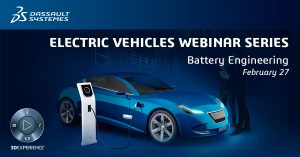Designers of electric, connected and autonomous vehicles are at somewhat of a disadvantage, as they are expected to do in five or 10 years what the designers of internal combustion engine vehicles did over the course of 100 years: create a new, fully realized mode of transportation. But today’s engineers do have an advantage over their predecessors: access to simulation technology. Simulation dramatically accelerates vehicle development, allowing engineers and designers to model, address and eliminate issues before a physical prototype is even made.
One of the biggest differences between cars of the past and cars of the future is that batteries are replacing fuel tanks. These batteries are extremely complex systems requiring advanced engineering methods, from chemistry to cell engineering, to module and pack engineering, and integration into full vehicles. Dassault Systèmes is investing in technologies that will help develop solutions addressing the needs of vehicle electrification, including battery engineering.
We are excited to announce “Solutions for Digital Battery Engineering,” a new webinar presented by Dassault Systèmes and SAE International, discussing how these solutions can be applied to the complicated process of battery engineering. The webinar will be held on February 27th at 10 AM EST and will be led by Fabien Letailleur, Senior Manager, Transportation and Mobility Initiatives for Dassault Systèmes, and Youngwon Hahn, Senior Industry Solutions Manager for Dassault Systémes. Fabien and Youngwon will discuss various types of batteries and how Dassault Systèmes’ simulation solutions can be applied to their development.
Three major challenges in battery engineering will be discussed. Cell engineering involves the simulation of expansion due to state of charge, ultrasonic welding, and mechanical analysis, while module and pack engineering involves mechanical analysis, topology optimization, and concept analysis. Finally, full vehicle integration involves the simulation of PSD fatigue and crash/penetration analysis.
Webinar attendees will learn about these challenges in detail, as well as the products that can be used to address them, which include Abaqus, Tosca, Simpack, PowerFLOW, XFlow, and CST.
Interested in learning more? Registration for the webinar is now open and free of charge, and the recording of the presentation will be available afterwards for those who cannot attend at that time. A question and answer session will immediately follow. Register, here.
Want to learn more about how SIMULIA is steering the digital future of electric, autonomous and connected vehicles? Visit our dedicated page.
Also, check out some of SIMULIA’s other blog posts on battery engineering, here.

